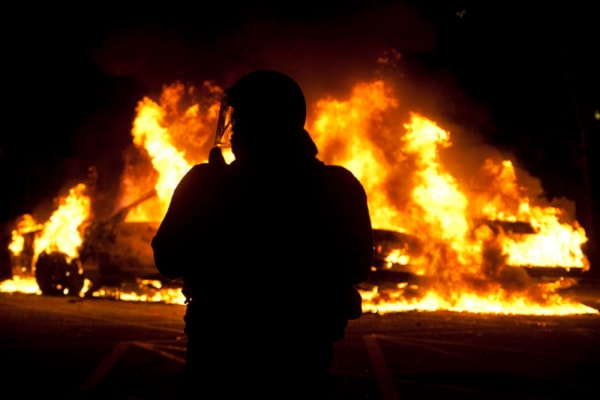VANCOUVER — Police were in a state of confusion and had lost control of the massive crowd hours before Game 7 of the Stanley Cup series even began, says a report reviewing the June 15 riot.
The report released Thursday paints a picture of a crowd ballooning out of control before the puck dropped, with thousands of people packing the city’s downtown, many of them fuelled with alcohol.
The scenario had passed police by and when the riot was in full swing, they found themselves without the right gear or tools that worked.
Doug Keefe, a former deputy justice minister who did the review with former Vancouver Olympic committee head John Furlong, said police began arriving very slowly on the evening before the Vancouver Canucks faced off against the Boston Bruins.
“The fans arrived before most of the police,” Keefe said. “The opportunity to set the tone was lost.”
Even if they’d had the chance, maintaining that tone would have been impossible, he added.
The report issued by Keefe and Furlong contains 53 recommendations for doing things differently in the future.
Among them are suggestions for more powers to dampen the sale of alcohol for regional events, that a regional tactical squad made up of the RCMP, the Vancouver police and others be formed to deal with huge public events and that a special court be established to deal with people accused of rioting.
The crowd ballooned to 155,000 as people, many already drunk and spurred on by social media, poured into the downtown core, overwhelming police and pushing against the barricades that were supposed to have held them back. One officer noted that some people who wanted to get away from the crushing crowd couldn’t do that.
Keefe said Vancouver police had successfully used a meet-and-greet strategy in the previous games, mingling with the crowd and making their presence known.
But that was impossible from the outset on June 15.
“The meet-and-greet strategy... cannot function in that (size of crowd.) You cannot meet and greet anybody, you cannot navigate that crowd.”
When it became clear police had to shift gears and move into riot mode, communication and logistical problems meant it took up to 40 minutes for officers to change into their gear and get back on the ground.
The riot gear was stashed too far away from the where the officers were stationed and by the time the riot squad got there and officers returned to their posts, the fires were already burning.
The report found the RCMP commander at the south end of the crowd had a Vancouver police radio that didn’t work and as a result, didn’t hear the order for officers to get into their riot gear.
This meant the officers weren’t wearing the right equipment for the job they were suddenly being ordered to do and the RCMP at that end of the riot ended up being out of radio contact for the rest of the riot.
It also meant that small groups of RCMP weren’t able to change into their gear gradually, meaning when they all had to do that at once, there was a “major drop” in police presence at that end of the crowd.
Finally, the report notes that communication with the crowd is considered crucial to ensure police can encourage people to move on before the tear gas starts to fly.
But the report found the batteries on the Vancouver police’s loudspeaker hadn’t been charged, meaning it could only work while attached to a police vehicle.
As for the RCMP, their loudspeaker malfunctioned so the crowd was not warned that tear gas was coming.
“Communication was not used with this crowd until the situation was out of hand,” the report notes.
Police Chief Jim Chu said the report shows there were some problems, but overall, the force performed well.
“We know in hindsight that some mistakes were made, but I’m pleased to see the reviewers concluded that none of the mistakes would have made a substantial difference that night.”
Chu continued to insist there was no way his force could have predicted a riot. The report backs up his contention that there was no police intelligence suggesting there might be one.
Keefe and Furlong also said the riot was propelled through the participants’ social media postings. The only way to counter that, they maintain, is for the police to use social media for their own ends.
The report said many people in the crowd that night just wanted to get out of it, but there was much misinformation flying across social media, including rumours of train station closures and ferry cancellations.
The report notes that technology called cell broadcasting is used in India and South Korea. It could enable police to send official text messages to all cell phones within the range of specific cell towers.
